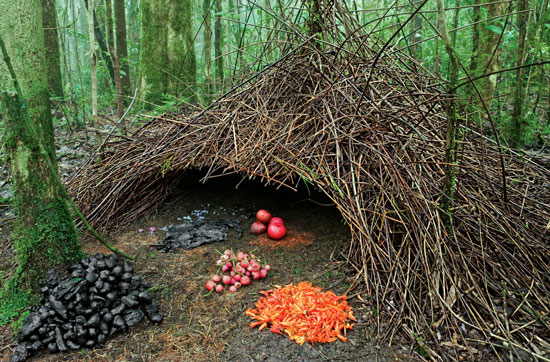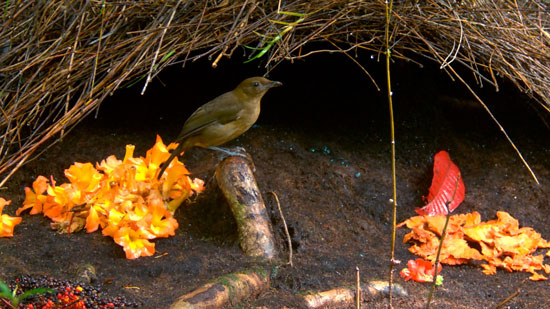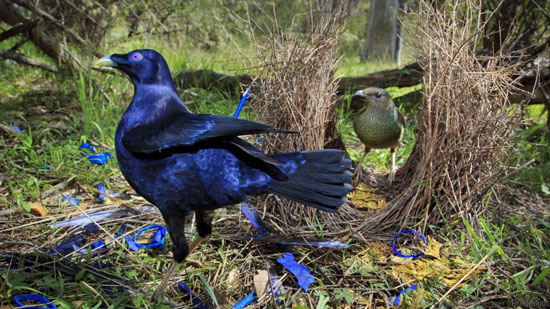|
In my novel, Diffusion, Quentin finds a stone talisman that turns out to be very important. But the place where he finds it is interesting as well. The talisman is basically a small stone (although carved to resemble a creature). It is found by a male BOWERBIRD and incorporated into the bird's elaborate "bower," where Quentin eventually finds it. Bowerbird bowers are part of a mating ritual that is almost beyond belief. In order to impress females, the male bowerbird creates a spectacular structure with sticks, clears away the ground in front of it, and then painstakingly collects "treasures" and puts them into neat piles, sorted by size, texture, and color. There are about 20 species of bowerbirds, ranging from bright orange in color to dull brown. Most of them live in New Guinea and/or northeastern Australia. I've always been fascinated by the fact that, in most animals, it is the males that have developed incredible behaviors and physical characteristics to attract mates. It is the male's job to prove he is worthy (healthy and strong... in other words, likely to produce healthy, strong offspring). It is the female's job to be aloof and picky. Much research has been done on this, and it has to do with the amount of energy females put into producing offspring compared to males (as in A LOT MORE!). But that's a topic for a future email. Check out this video from the BBC of the courtship of the flame bowerbird (prepare to be amazed): https://www.youtube.com/watch?v=1XkPeN3AWIE Amazing Facts about Bowerbirds: Male regent bowerbirds actually paint the sticks that make up their bower. They do this with their blue or green saliva, often painting it on using a leaf as a paintbrush. A rare example of tool use in birds! The Vogelkop bowerbird creates bowers that are a meter high and 1.5 meters wide (see the photo below). They decorate their "lawn" with piles of brightly-colored flowers and other objects. Whenever these start rotting or loosing their color, the birds replace them with fresh ones. When bowerbirds live near civilization, they often collect human-made objects because they are bright-colored. The Satin bowerbird below has collected pieces of blue plastic. Notice the drab female watching him perform from inside the bower. Male bowerbirds work so hard on their bowers, expending valuable energy doing so, that this has resulted in the habit of raiding each other's bowers. When a male leaves his bower unguarded, another male might swoop in and steal some of his hard-earned treasures. Sometimes they even tear down the bower structure itself. That is terribly rude, but I guess all is fair in love and war. Males build their bowers so the sun will shine on their bright treasures and on themselves. After all, the best presentation will win the female. So in forests with an open canopy, they build them with a north-south orientation. In a closed canopy forest, they build them near a gap in the canopy. So the bowerbird deserves a place in the P.A.H.O.F. (Prestantious Animal Hall of Fame). FUN FACT: Prestantious is from a latin word meaning excellence. It is a very rare word, as it has appeared only once in the Oxford English Dictionary, stating that it was used once in a book written in 1638, The Blood of the Grape. Basically, it means awesome. Photo Credits: Bowerbird bower - Ingo Arndt/National Geographic Vogelkop Bowerbird - BBC (http://www.bbc.co.uk/programmes/b04dwdm3) Satin Bowerbirds - Gerhard Koertner / Photoshot - BBC
1 Comment
kp
5/16/2019 11:33:34 am
nice i like this
Reply
Leave a Reply. |
Stan's Cogitations
Everyone needs a creative outlet. That's why I write. Archives
July 2024
|




 RSS Feed
RSS Feed